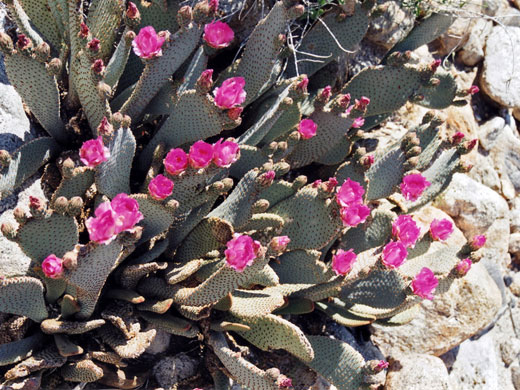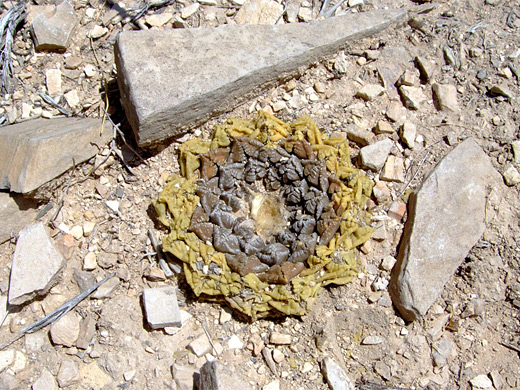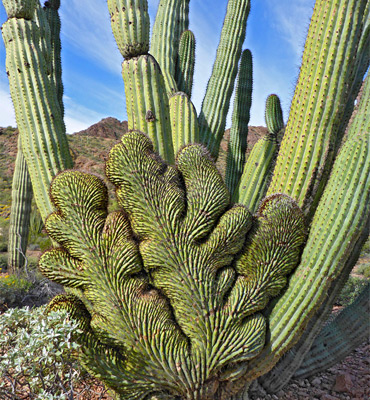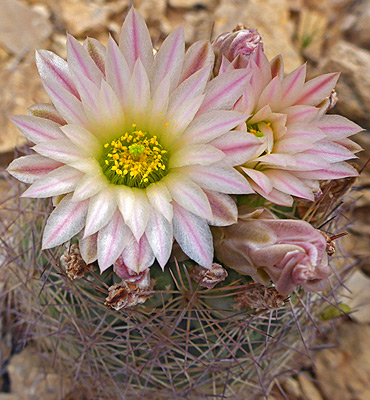Cacti of West and Southwest USA
Plants > Cacti
Cacti are the most distinctive plants of Southwest USA, and the majority occur in the four southernmost states of California, Arizona, New Mexico and Texas, especially in the
Sonoran,
Mojave and
Chihuahuan deserts, where they are very widespread and numerous. Further north, some types like
opuntia and
echinocereus are still quite abundant, while there are also a number of smaller plants with much more limited distribution, such as the
sclerocactus and
pediocactus species.
The six cactus genera with the largest number of species, and hence most likely to be encountered, are
cereus,
cylindropuntia,
echinocereus,
ferocactus,
mammillaria and
opuntia.
Less common genera include
ariocarpus,
coryphantha,
echinocactus,
echinomastus,
epithelantha,
escobaria,
glandulicactus,
grusonia,
pediocactus,
sclerocactus and
thelocactus, while the rarest genera (with the number of US species), are acanthocereus (1), ancistrocactus (2), astrophytum (1), hamatocactus (1), lophophora (1) and neolloydia (1), plus a few that occur only in Florida.
State cactus species lists:
Arizona,
California,
Colorado,
Nevada,
New Mexico,
Texas,
Utah.
Key to the major cactus genera
Common Southwest Cactus Genera
Cereus
Cereus and related species are tall, often tree-like cacti, and only three are common in the Southwest: the
saguaro (carnegia genus),
senita (pachycereus genus) and
organ pipe (stenocereus genus). The latter two occur most visibly in Organ Pipe Cactus National Monument but the saguaro is widespread, one of the universally recognized symbols of this region.
The only other cereus-like plants in the US include
bergerocactus emoryi in southern California and
peniocereus greggii in south Arizona, New Mexico and Texas. Many more varieties of columnar cacti are found in Mexico, Baja California and South America.
Cylindropuntia
Cylindropuntia (
cholla) cacti are a variety of opuntia that have slender, cylindrical stem segments instead of flat, rounded pads, but share other traits including branching profusely to form large clumps, and having small bristles (glochids) in addition to the regular spines.
The majority of species have a very dense covering of spines, sometimes completely obscuring the green stems beneath, and cholla are a familiar sight across a variety of Southwest habitats, from the hottest deserts of Arizona and California to the grassy plains of New Mexico. Most species flower abundantly. Spines are covered by a thin, papery sheath, a feature not present in the
opuntia.
Echinocereus
Known generally as
hedgehog cactus,
echinocereus is a common, widespread genus characterized by low clumps of cylindrical or conical stems, sometimes containing a hundred or more segments, and conspicuous red or pink flowers. They grow over a wide range of environments, from the low, hot deserts to cool mountain slopes, but most prefer unshaded conditions.
Spines are arranged along vertical ribs, and are always straight, never hooked. There is quite a wide variation in appearance even within individual species, with various subspecies recognized, and it can be difficult to identify a particular specimen.
Ferocactus
Ferocactus (
barrel cactus) plants are characterized by many heavy spines, growing along prominent ribs, and they include the large, common and widespread barrel cacti found in the hottest parts of the deserts of Arizona and California, some becoming up to ten feet high.
There are also two less common US species - ferocactus viridescens in far southwest California, and ferocactus hamatacanthus in Texas and New Mexico. As with cer
eus, far more varieties of ferocactus are found further south in Baja California and Mexico.
Mammillaria
Mammillaria are generally small, often delicate plants, usually forming clusters, with a wide variety of color, spination and flowers. Spines grow at the end of small tubercles rather than ribs - a characteristic shared with certain other, less numerous genera such as
coryphantha and
escobaria - and often include one of more longer central spines, which may be straight (
pincushion cacti) or curved (
fishhook cacti), surrounded by smaller radial spines.
Flowers come not from the apex but lower down, in a ring around the upper part of the stem, and this helps to distinguish them from similar species, as these tend to flower from the tip.
Opuntia
Opuntia ('
prickly pears') are branched, joined cacti, usually densely spined, though a few species have no spines. They are characterized by flattened pads, unlike the related
cylindropuntia genus (cholla), where the pads are cylindrical. Some opuntia become large and tree-like while others stay at ground level, often forming extensive mats.
There are many Southwest varieties, often similar in appearance, a few hybridized and many difficult to identify. The regular spines are surrounded by tiny bristles known as glochids, which are very irritating to the skin if touched.
Other Southwest Cacti Genera
Ariocarpus
Ariocarpus, the living rock cactus, has just one US representative, found only in the Big Bend region of west Texas. Another half dozen species occur in Mexico, and all are quite rare.
Coryphantha
Coryphantha cacti look like mammillaria in that they are small, have tubercles rather than ribs, and are solitary or form closely-spaced clusters; the main difference is that flowers are borne at the tip, rather than a little way down the stem. They are commonly known as beehive cacti, or topflower cacti.
Echinocactus
Echinocactus plants resemble some of the ferocactus species; they are spherical or barrel shaped, have dense and/or thick spines arranged along ribs, and may be single or clustered, though they do not reach the great heights (up to ten feet) of the larger ferocacti.
Echinomastus
Echinomastus, or pineapple cacti are usually single, forming small globes or cylinders characterized by tubercles arranged in rows, all quite spiny. There are six US species, all with limited distribution, mostly in Arizona and Texas.
Epithelantha
Epithelantha, button cacti, are characterized by spherical or short-columnar stems completely covered by numerous, short, white or light grey spines, up to 90 per areole. Fruits are tubular, reddish, while the flowers are small, borne right at the tip of the stems, and colored pink or pale orange.
Escobaria
Known variously as foxtail cactus, pincushion cactus or spiny star,
escobaria is another group of small, tubercular cacti, similar to mammillaria and coryphantha. The US has over a dozen species, most relatively uncommon.
Glandulicactus
There is only one US species in the
Glandulicactus genus; a small group of stout, cylindrical cacti for which the main distinguishing feature is hooked radial spines in addition to the longer, hooked central spine. Plants were formerly included in the sclerocactus genus.
Grusonia
Grusonia cacti are a type of cholla, characterized by short, club-shaped stem segments with pronounced tubercles bearing especially strong, sharp, dense spines, usually flattened and tapered. They form low mats, often covering a wide area.
Pediocactus
The
pediocactus genus include some of the smallest species in the US, growing mostly in north Arizona and Utah. All are rare, and most occur in very localized areas, sometimes of just a few square miles.
Sclerocactus
Sclerocactus cacti resemble the echinocereus species but are usually single and have central spines that are hooked rather than straight, hence their common name of fishhook cactus. Upwards of 20 different types have been identified, found in higher elevation desert regions. Spines grow from tubercles arranged in prominent ribs.
Thelocactus
Most
thelocactus cacti are found only in Mexico; just one species grows in the USA, primarily in the Big Bend area of west Texas. The plants are small, globular or cylindrical, usually solitary, and produce large showy flowers right from the growing tip.



















